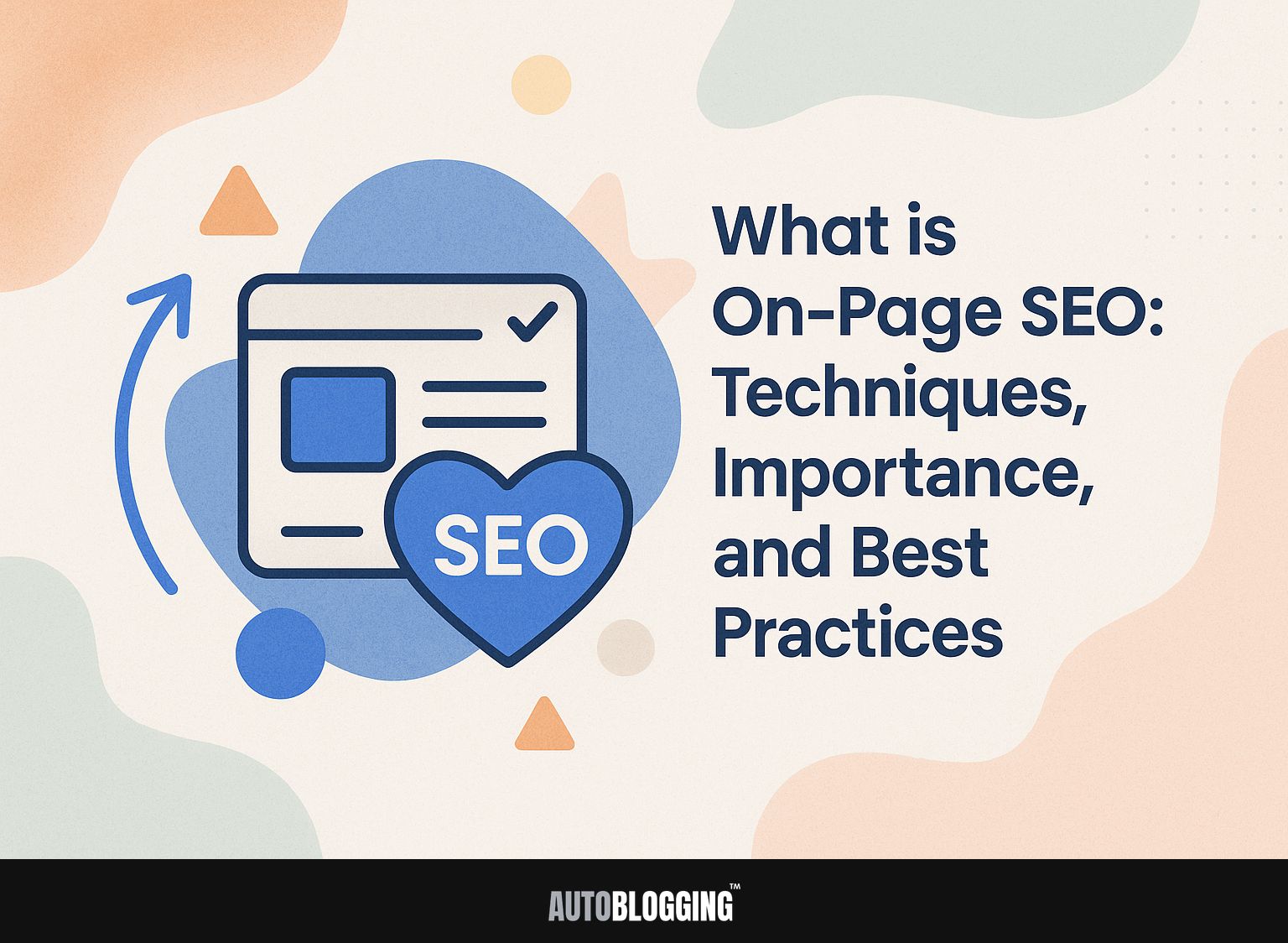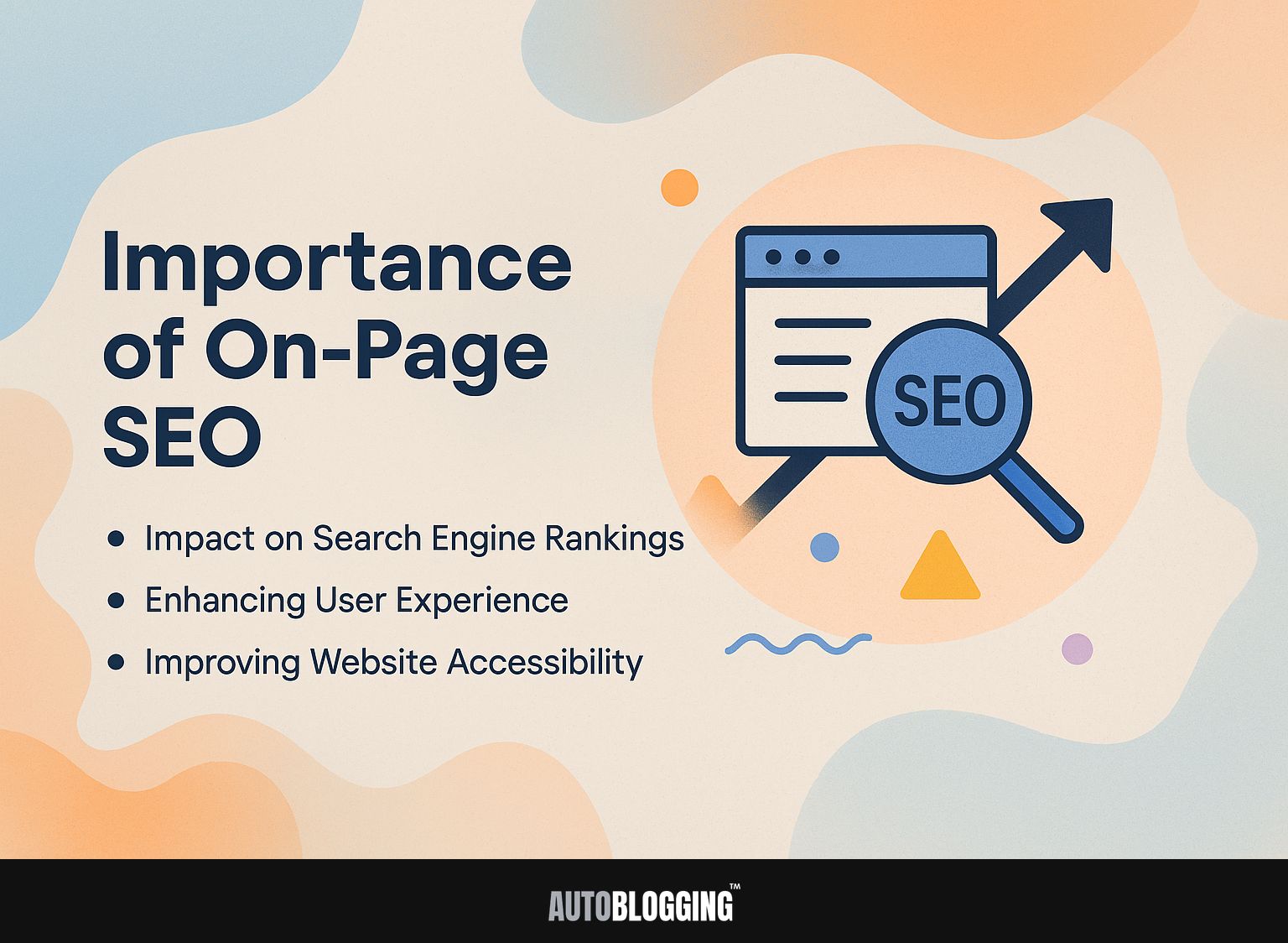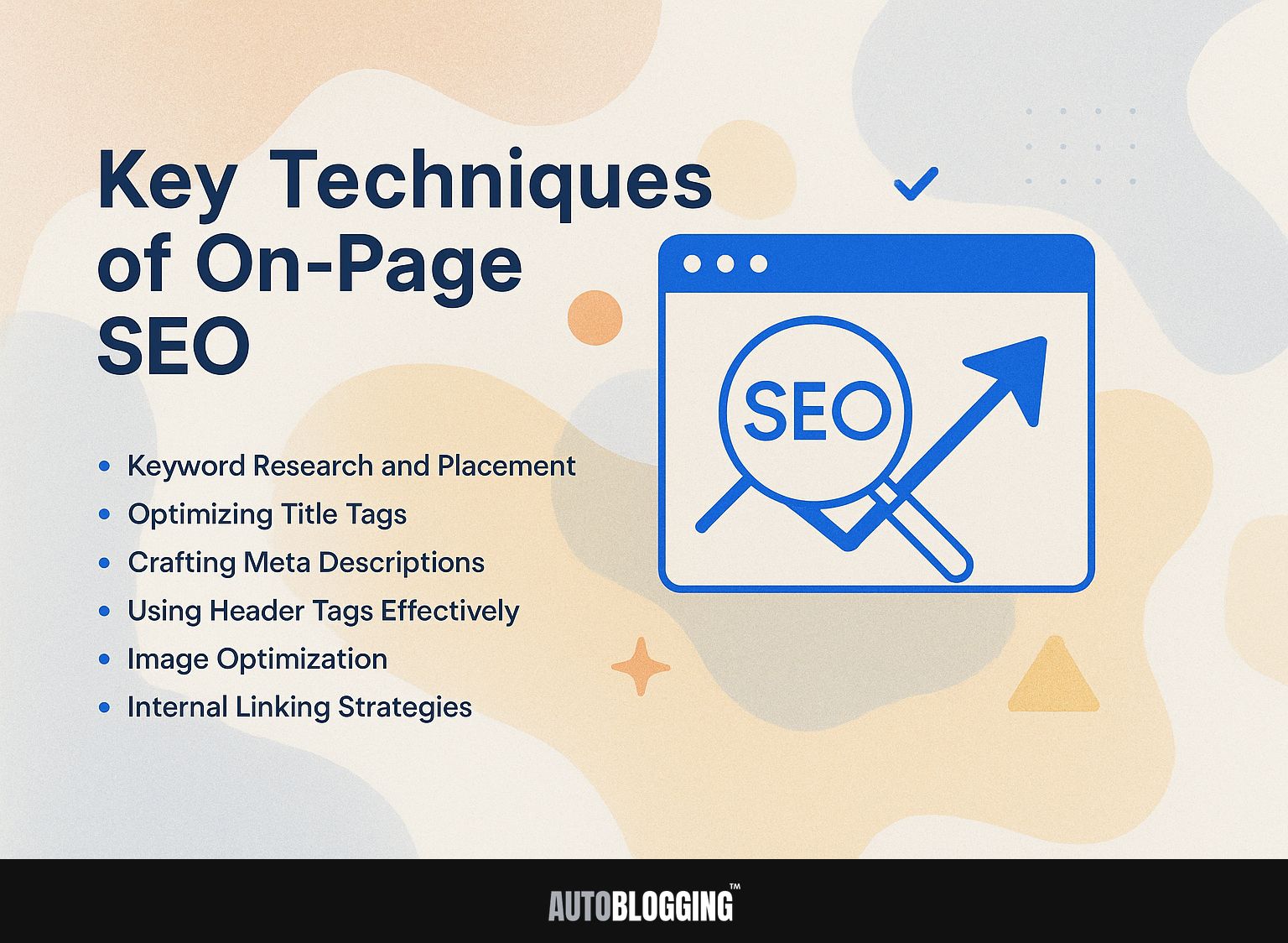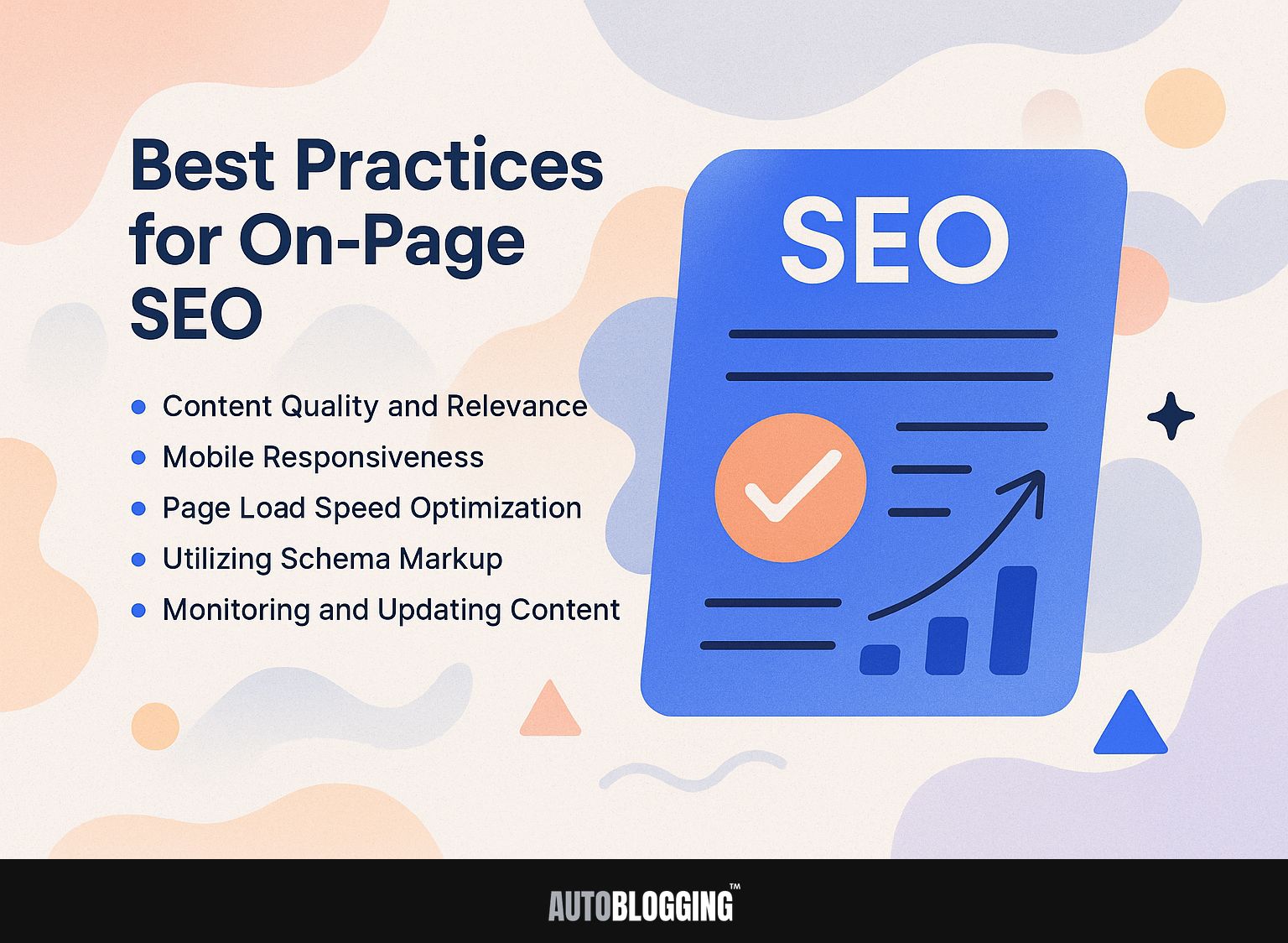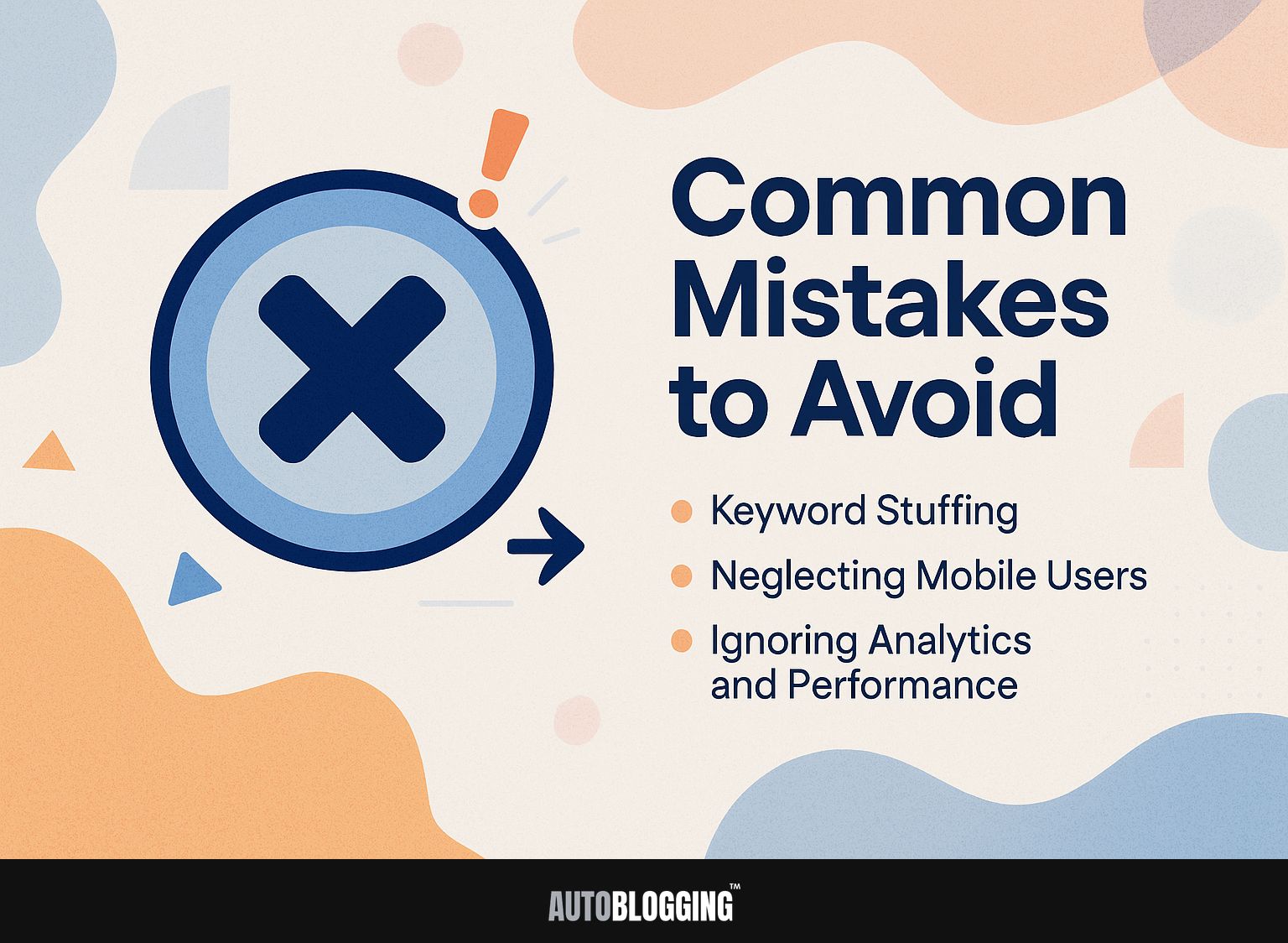Improving on-page SEO is important for increasing your website’s visibility on search engines like Google. By learning how to improve title tags and using internal links wisely, you can improve your SEO strategy and increase natural website visits. In this article, we’ll look at why on-page SEO is important, how to do it effectively, and the best ways to make sure your content ranks well and connects with your audience.
Key Takeaways:
- On-page SEO is the optimization of website content and HTML source code to improve search engine rankings, user experience, and website accessibility.
- Important methods for improving on-page SEO involve finding and using the right keywords, improving meta descriptions, and using header tags correctly.
- Best practices for on-page SEO include creating high-quality and relevant content, ensuring mobile responsiveness, and regularly monitoring and updating website content. Avoid common mistakes such as keyword stuffing and neglecting mobile users to see better results.
Contents
- Importance of On-Page SEO
- Key Techniques of On-Page SEO
- Best Practices for On-Page SEO
- Common Mistakes to Avoid
- Frequently Asked Questions
- 1. What is On-Page SEO and why is it important?
- 2. What are the key techniques used in On-Page SEO?
- 3. How does On-Page SEO differ from Off-Page SEO?
- 4. What are the best practices for On-Page SEO?
- 5. How can On-Page SEO help improve website traffic and conversions?
- 6. Is On-Page SEO enough for a successful website?
1. Definition of On-Page SEO
On-page SEO means changing each web page to improve search rankings and draw users by using various techniques and strategies.
Key components of on-page SEO include keyword optimization, content quality, and HTML source code adjustments.
For example, when improving a blog post for the keyword “best organic skincare,” make sure it is included in the title, headings, and naturally throughout the text. Write useful and interesting content related to this keyword that meets what users are looking for, such as product reviews or comparisons.
Fine-tune your HTML tags-like meta descriptions and alt text for images-to include this keyword. This method increases the likelihood of appearing higher in search engine results.
2. How On-Page SEO Differs from Off-Page SEO
While on-page SEO focuses on elements within a website, off-page SEO emphasizes external factors like backlinks and social signals that influence search rankings.
On-page SEO includes changing meta tags, improving site speed, and making sure it functions properly on mobile devices. For example, using tools like Yoast SEO can improve on-page elements by providing instant feedback.
Off-page SEO, on the other hand, thrives on building authority through quality backlinks from reputable sites, as well as engaging on social media to drive traffic.
Using both strategies together usually leads to better search engine visibility and improves how users experience the site since on-page updates affect how visitors move through and view the site.
Importance of On-Page SEO
On-page SEO plays a big role in how search engines rank your website and how users engage with it. Improving your website’s visibility in search results and making it user-friendly are important. To enhance these efforts, understanding the role of URL structure in SEO can significantly boost your search engine performance.
1. Impact on Search Engine Rankings
Improving on-page SEO can increase search engine rankings by adjusting things like title tags, headers, and keyword placement, leading to better visibility.
An important part is the title tag, which should be short, about 50-60 characters, and have main keywords at the start. For instance, a title like “Affordable Skincare Products for Oily Skin” can directly target specific searches.
Similarly, writing a good meta description can improve click-through rates; aim for 150-160 characters that summarize the content in an interesting way.
Using header tags (H1, H2) helps organize content, making it easier to read and highlighting key points for both readers and search engines. Integrating these strategies can lead to significant improvements in your site’s performance.
2. Enhancing User Experience
Improving on-page SEO helps make the content simple to read and move through, which keeps visitors interested and reduces the likelihood they will leave soon.
Key parts include easy-to-use menus that help users find information quickly, and organized data that tells search engines about your content.
Tools like Google Analytics can track metrics such as time on page and bounce rates, allowing you to evaluate the impact of these changes.
For example, a site redesign that improves responsive design across devices often sees a notable drop in bounce rates, indicating that users appreciate the improved access and usability. Keep track of these metrics regularly to improve your SEO plan.
3. Improving Website Accessibility
A good website allows all users, including those on mobile devices, to easily locate and access content.
To help people use content more easily, add alt text to every image so screen readers can tell what the pictures are.
Use semantic HTML to clearly define the page structure, making it easier for screen readers and similar tools to understand. Make sure your site works well on mobile devices by adjusting to different screen sizes.
Tools like Google’s Lighthouse can check your accessibility scores and offer practical advice. By focusing on these aspects, you reach a wider audience and improve your site’s SEO performance.
Key Techniques of On-Page SEO
Using particular on-page SEO methods can greatly improve a website’s visibility and relevance to search queries.
1. Keyword Research and Placement
Effective keyword research, using tools like SEMrush or Ahrefs, allows content creators to identify high-volume keywords and strategically place them for maximum impact. For those looking to expand their toolkit, it’s worth exploring the top keyword research tools available in 2023.
- Start by entering seed keywords into your chosen tool to generate keyword ideas. Analyze metrics such as search volume and keyword difficulty to prioritize which to target.
- For instance, a lifestyle blog identified ‘healthy meal prep’ as a promising phrase with high search volume and low competition. Once you choose important keywords, put them in your titles, headers, and main text to improve SEO.
- This strategy helped the blog increase its organic traffic by over 40% within three months, demonstrating the power of effective keyword optimization.
2. Optimizing Title Tags
Including important keywords in title tags is important because they affect how frequently your site shows up in search results and how many clicks it gets. Titles with keywords get 36% more clicks.
To improve your title tags, keep them under 60 characters, include your main keywords, and make them appealing. For instance, instead of a generic title like “Best Coffee Beans,” opt for “Top 10 Organic Coffee Beans for Smooth Mornings.”
Tools like Yoast SEO provide real-time feedback, ensuring you hit the right word count and keyword density. Check how your page is doing often using tools like Google Analytics, and adjust your plans to match what your audience likes.
3. Crafting Meta Descriptions
Good meta descriptions can boost click-through rates by about 5%, which makes them important for on-page SEO.
To write useful meta descriptions, keep them between 150-160 characters and include your main keywords to improve search result visibility.
For example, if your article is about healthy eating, a description like “Here are 10 easy tips on eating well for a balanced diet today!” works well.
Add a clear call to action, like “Find out more!” or “Act now!” Test different versions with A/B testing to see which description works best, helping you improve your strategy for better engagement.
4. Using Header Tags Effectively
Using header tags (H1, H2, H3) helps arrange content, makes it easier to read, and aids SEO by showing search engines the order of information.
Start by ensuring your H1 tag is unique and captures the primary topic of the page, incorporating relevant keywords.
Use H2 tags for subtopics to organize your content. This helps readers quickly find the information they need. H3 tags can go deeper into those subtopics, giving more details.
For example, an article on digital marketing might have a main heading like “The Complete Guide to Digital Marketing,” followed by subheadings such as “SEO Tips” and “Using Social Media for Marketing.” This clear layout helps both readers and search engines follow your content’s organization.
5. Image Optimization
Making images smaller and using clear alt text can greatly speed up page loading and help with SEO.
- Start by compressing images with tools like TinyPNG or JPEGmini, which can reduce file sizes by up to 75% without noticeable loss in quality.
- Next, make sure each image has alt text that explains what it shows. This helps people who use screen readers and improves SEO.
- Choose the right file format: use JPEG for photographs and PNG for images with transparency or text.
For example, a website that implemented these strategies saw a decrease in load time from 8 seconds to 3 seconds, enhancing user experience and search rankings.
6. Internal Linking Strategies
Strategic internal linking improves the way users move around a website, helps them find information, and shares page authority throughout the site.
To implement effective internal linking, focus on linking to relevant content that complements the current page. Use clear and specific words in your anchor text to show what the linked page is about. This helps both people and search engines know what the link contains.
For example, a blog about pet care can link to specific articles on dog grooming or pet nutrition. This method makes user experience better and also improves SEO by enhancing page authority.
Healthline.com showed this by greatly growing its natural website visits with a clear internal linking method. Additionally, understanding the factors that influence page authority can be crucial-our detailed guide on what is Page Authority and how to improve it offers further insights into optimizing your internal links for better results.
Best Practices for On-Page SEO
Following effective methods for on-page SEO makes sure content is suitable for search engines and users, which results in better interaction and increased sales.
1. Content Quality and Relevance
High-quality, relevant content that aligns with user intent is essential for effective on-page SEO and can lead to lower bounce rates and higher engagement.
To make this content, begin by doing keyword research with tools like Ahrefs or SEMrush to find out what terms your audience is looking for.
Then, outline your content focusing on answering specific questions or problems. For example, a blog post about healthy eating might break down meal prep into actionable steps, like planning a weekly menu or batch cooking.
Look at performance data, like how long users stay on a page and how often they click on links, to improve upcoming content. Research indicates that content with more interaction often improves SEO rankings.
2. Mobile Responsiveness
It’s important for websites to function properly on mobile devices since 54% of global web traffic comes from them. This impacts how users interact with the site and affects search engine rankings.
To evaluate your site’s mobile-friendliness, use tools like Google’s Mobile-Friendly Test, which analyzes how easily a visitor can use your page on a mobile device.
For a more thorough approach, think about using flexible design methods. Start with flexible grid layouts that adjust to various screen sizes, ensuring elements such as images and buttons scale accordingly.
Make your pages load faster by reducing image sizes and using browser caching. Slow pages can cause visitors to leave your site. By combining these methods, the user experience improves, and your SEO results increase.
3. Page Load Speed Optimization
Improving page load speed is important because a one-second delay can lower conversions by 7%, which is a major part of on-page SEO.
- To improve page speed, start by minimizing HTTP requests; combine CSS and JavaScript files where possible.
- Use a Content Delivery Network (CDN) like Cloudflare to share your content quickly around the world.
- Image optimization is another critical step; tools like TinyPNG and ImageOptim can compress images without sacrificing quality.
- Check your site’s loading speed often using tools like GTmetrix or Google PageSpeed Insights to find ways to make it faster.
By following these steps, you can greatly improve how users engage with your site and increase the number of users who complete the desired actions.
4. Utilizing Schema Markup
Using schema markup can improve search results by allowing rich snippets, which can increase click-through rates a lot.
To use schema markup well, start by finding the main types that match your content.
For example, apply the ‘Article’ schema to blog posts to improve search results with titles and publication dates. For e-commerce sites, incorporating the ‘Product’ schema can display price and availability directly in search.
Tools like Google’s Structured Data Markup Helper simplify the process of creating markup. Just input your URL or code, select the appropriate schema, and Google will help format it. Afterward, check your markup using the Rich Results Test tool to make sure it is set up correctly.
5. Monitoring and Updating Content
Checking and refreshing content regularly keeps it useful and helps improve search rankings and interaction.
To perform a useful review of your content, begin with tools like Moz or SEMrush to check metrics like traffic, bounce rate, and keyword positions.
Identify content that underperforms or is outdated and evaluate it for potential revisions. Update these pieces by using the most recent data, choosing keywords based on what is popular now, and improving visuals to make them more engaging.
This process refreshes your content and adjusts it to follow SEO rules, leading to better visibility and keeping your audience engaged.
Common Mistakes to Avoid
Staying away from frequent errors in on-page SEO can help avoid penalties and lead to more successful search results, as mentioned in our guide on how alt tags and EXIF data can enhance SEO.
1. Keyword Stuffing
Using too many keywords makes the text hard to read and can cause search engines to punish the content, reducing how often it appears in search results.
To avoid keyword stuffing, focus on incorporating keywords naturally within your content. Use your main keyword once every 100 to 200 words to achieve a keyword density of 1-2%.
For example, in a gardening article, rather than saying “gardening tips” too often, mention it naturally, like ‘Here are some key tips to help you grow a healthy garden.’ This method makes the content simple to read and better for users, making it appealing to both people and search engines.
2. Neglecting Mobile Users
Neglecting mobile users can result in a significant loss of traffic and engagement, as mobile usability is a ranking factor for search engines.
In fact, over 54% of web traffic now comes from mobile devices, highlighting the need for optimization.
To make sure your site works well on mobile devices, begin by using a responsive design that changes your layout to fit various screen sizes. Use tools like Google’s Mobile-Friendly Test to find problems.
Prioritize loading speeds; aim for under three seconds by compressing images and minimizing scripts. Make sure buttons can be clicked easily and text is clear to read without needing to zoom in. These strategies improve user experience and can also help your rankings.
3. Ignoring Analytics and Performance
Not paying attention to analytics can result in missing chances to do better, as performance data shows important details about how users act and how well the content works.
Using tools like Google Analytics can greatly improve your on-page SEO. Start by monitoring metrics such as bounce rate, average session duration, and user demographics.
For example, if a high bounce rate is detected on a specific page, consider improving content clarity or adding calls to action.
Analyze the keywords driving traffic. If specific words are not drawing much attention, consider adjusting the content to make it more relevant. Regularly checking this information helps make changes based on what users like.
Frequently Asked Questions
1. What is On-Page SEO and why is it important?
On-Page SEO means improving individual web pages to make them rank higher in search engines and bring in more natural traffic. It involves techniques such as keyword research, content optimization, and HTML tags. On-Page SEO matters because it helps search engines know what a website’s content is about, which can lead to a better ranking in search results and more visibility to people looking for similar information.
2. What are the key techniques used in On-Page SEO?
Some of the important methods in On-Page SEO are picking and using keywords, improving content, setting title tags and meta descriptions, linking within the site, and improving images and videos. These methods make the website more useful and important to both search engines and users, which helps it show up better in search results.
3. How does On-Page SEO differ from Off-Page SEO?
On-Page SEO is about improving the content and structure of web pages themselves, whereas Off-Page SEO includes actions taken outside the website, like getting backlinks and using social media to promote it. Even though both methods are important for improving a site’s rank in search results, On-Page SEO can be directly controlled by the site owner, which allows for faster adjustments and visible results.
4. What are the best practices for On-Page SEO?
Effective On-Page SEO means using the right keywords in your text, making page titles and meta descriptions better, writing good and engaging content, using clear URLs that are easy for search engines, and ensuring the website is quick and simple for users to use. It is also important to regularly monitor and update these practices to stay current with search engine algorithms and trends.
5. How can On-Page SEO help improve website traffic and conversions?
On-Page SEO can bring more visitors to a website and improve sales by making the website easier to locate and more relevant for people searching for specific keywords or phrases. Making changes to the website’s text and layout helps users find information more easily, which can lead to more visitors becoming customers or subscribers.
6. Is On-Page SEO enough for a successful website?
No, On-Page SEO is only one aspect of a successful website. It must be combined with Off-Page SEO, as well as other digital marketing strategies such as social media, email marketing, and paid advertising. A successful website needs a balanced plan to draw in visitors, keep them coming back, improve search engine results, and increase sales and income.



